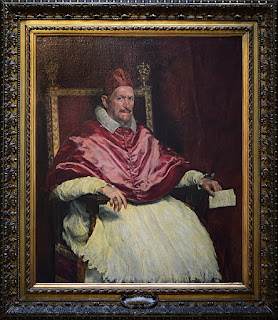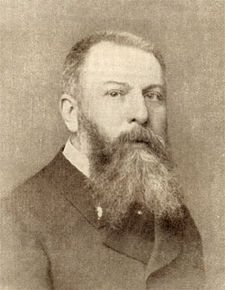Political pontiff dominated by sister-in-law
 |
| The portrait of Innocent X by the Spanish artist Diego Velázquez, notable for a terse facial expression |
Described by some historians as a scheming and bitter pontiff,
Innocent X’s tenure was notable for his malicious attack on a rival family, his
destruction of the ancient city of Castro, a squabble with France that almost ended
in war, his interference in the English Civil War and his refusal to recognise
the independence of Portugal.
It was also overshadowed by rumours of an immoral relationship
with his sister-in-law, Olimpia Maidalchini, the widow of his late brother. Historians
generally agree that these were unfounded, yet Innocent X was dominated by her
to the extent that she became the most powerful figure in his court, her influence
so strong that ambassadors, cardinals and bishops knew that the pope would
defer to her before making any decision and consequently would address any
issues directly to her.
Born in Rome in 1574 and baptised as Giovanni Battista Pamphili,
he came from a wealthy and well-established family who originally came from
Gubbio in Umbria.
His parents, Camillo Pamphili and Flaminia de Bubalis,
groomed him from an early age with the ambition that he would one day become
pope.
 |
| Innocent X's predecessor, Urban VIII, as depicted by Caravaggio in 1598 |
Under Pope Gregory XV, he became nuncio (ambassador) to the
court of the Kingdom of Naples, and was sent by Urban VIII to accompany his
nephew, Francesco Barberini, whom he had accredited as nuncio, first to France
and then Spain.
In May 1626, he was made apostolic nuncio to the court of
Philip IV of Spain, an appointment that led to a lifelong association with the
Spaniards. He was made a cardinal in 1627 at the age of 53.
He was elected pope in 1644 after a long and stormy conclave
to find a successor to Urban VIII, undermined by the difficult relations
between the Spanish and the French.
Pamphili was put forward as a compromise candidate, despite his sympathies
towards Spain. Cardinal Jules Mazarin,
the de facto ruler of France, travelled to Rome to veto the appointment but
arrived too late.
Soon after his accession, having given himself the name of Innocent X, he began a legal action against
the Barberini family, long-time rivals of the Pamphili, for alleged misappropriation
of public funds.
It led the brothers, Francesco, Antonio and Taddeo Barberini,
to flee to Paris, where they found a powerful protector in Cardinal Mazarin. Innocent X confiscated their property and issued
a bull (decree) that all cardinals who might leave the Papal States for six
months without express papal permission would be deprived of their benefices
and eventually cease to be cardinals.
 |
| A painting by an unknown artist believed to show Olimpia Maidalchini |
Innocent X’s destruction of the ancient city of Castro in
Lazio seems to have been an act of revenge against Odoardo Farnese, Duke of
Parma, over a defeat suffered by Urban VIII and the humiliation that seemed to
hasten his demise.
His intervention in the English Civil War was to send the archbishop
of Fermo, Giovanni Battista Rinuccini, to Ireland as nuncio extraordinary,
along with a large quantity of arms, gunpowder and money, to support the
foundation of an independent Catholic-ruled Ireland, only for Oliver Cromwell to
hold sway and restore Ireland to his side.
Innocent X's decision to side with Spain over Portugal’s bid for
independence was consistent with his general policy of supporting Spanish
ambitions and, as an extension of that position, opposing France.
Although his papacy was dominated by political matters, he
did not entirely neglect ecclesiastical issues. The most important in his time concerned the condemnation of Jansenism, an interpretation of the teachings of St. Augustine about grace and free will that he
decreed was heretical.
He was cautious financially, although he did commission the
completion of the interior of St. Peter’s as well as the
transformation of Piazza Navona into the artistic masterpiece we see today, and
the restoration of Palazzo Pamphili, the home of Pope Urban VIII, which looks
out on the piazza.
Innocent X was pope for 11 years until his death in Rome at the age of 80. Religious historians are divided on his legacy, some believing he weakened the papacy, others that he increased its power. He was succeeded by Alexander VII, from the Chigi family.
Built on the site of the Roman Stadium of Domitian, Piazza
Navona became a public open space in the 15th century, when Rome’s main
market moved there from Campidoglio. It already contained the Fontana del Moro (Moors
Foutain) and the Fontana del Nettuno (Fountain of Neptune), sculpted by Giacomo
della Porta between 1574 and 1575, but Innocent X commissioned Gian Lorenzo
Bernini to create its magnificent centrepiece, the Fontana dei Quattro Fiumi
(Fountain of the Four Rivers) in 1651, which is topped by the Obelisk of Domitian,
moved from the Circus of Maxentius.
Gubbio, the town in Umbria from which Innocent X’s family
originated, is one of the best-preserved medieval towns in Italy, partly because,
perched on the side of Monte Ingino, it is not accessible easily enough to
attract hordes of visitors. Full of
narrow streets, alleyways and staircases, most of them dramatically steep, it
has been dubbed La Città del Silenzio – the City of Silence – for its sometimes
eerie serenity and calm.
Home
Home



